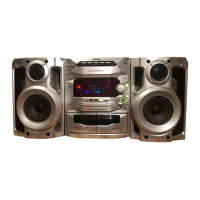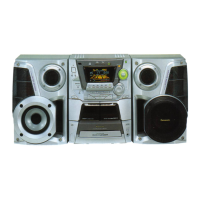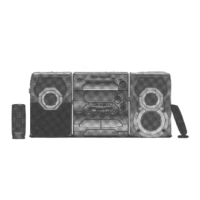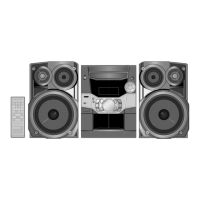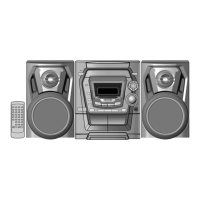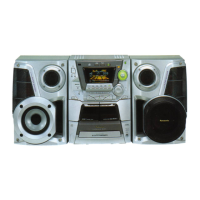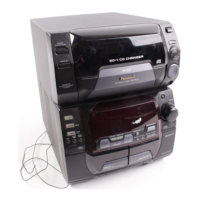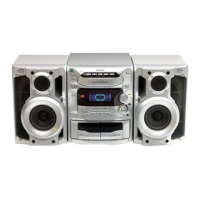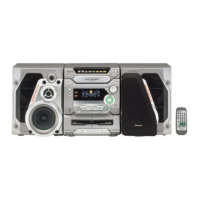Do you have a question about the Panasonic SC-AK15 and is the answer not in the manual?
Essential safety measures for operating the unit, including power, polarization, and cord handling.
Recommendations for positioning the unit to ensure proper ventilation and avoid environmental hazards.
Guidance on when to seek professional service for the unit and troubleshooting steps.
Instructions for correctly inserting batteries into the remote control transmitter.
Guidelines on mixing batteries, handling, and storage to ensure optimal performance.
Information on the correct method of using the remote control and operational notes.
Advice on how to protect the remote control from physical damage and misuse.
Step-by-step guide for connecting essential accessories like antennas and speakers.
Instructions for connecting an external FM antenna for improved reception.
Guide for connecting an external AM antenna to enhance broadcast reception.
Advice on efficiently tuning into radio stations for optimal signal reception.
Manual method for saving preferred radio stations into memory.
Information regarding how long preset stations are stored when the unit is unplugged.
How to adjust FM frequency allocation for compatibility with different broadcast standards.
Procedure for automatically scanning and stopping at available radio stations.
How to reduce noise in FM stereo broadcasts by switching to monaural mode.
Instructions for loading, unloading, and verifying the presence of CDs in the player.
Explanation of the indicators that show CD status (loaded, selected, playing).
Important guidelines to avoid damaging CDs and the CD player mechanism.
How to halt the sequential playback of CDs.
Instructions for temporarily pausing and resuming CD playback.
How to fast forward or rewind within a track during playback.
Method for moving to the next or previous track during playback.
How to select and play a specific CD from the loaded discs.
How to program and repeat specific tracks or a sequence of tracks.
Instructions on how to stop the random playback mode.
How to exit program mode and clear programmed tracks.
Information on how long programmed track sequences are stored.
How to recall and play a previously programmed track sequence.
Details on checking program contents, adding tracks, and canceling entries.
Selects and plays a single track from any loaded CD using the CD Manager function.
Procedures for reselecting CDs or tracks when an error occurs during playback.
Information on the types of cassette tapes that can be played correctly by the unit.
How to halt the playback of a cassette tape.
Instructions for setting up the unit to play two tapes in sequence.
How to start tape playback quickly when the unit is turned off.
Specifies which tape types are suitable for recording.
Guide on how to start recording from the correct point on a tape.
How to halt the recording process from a radio source.
Method for starting a recording at a particular point on the tape.
Using the Beat Proof function to minimize interference during AM radio recording.
How to end the recording process from a CD source.
Instructions for recording specific tracks from a CD based on a programmed sequence.
Preparatory steps before using the CD Manager function for recording.
Guide on how to record a specific track from a CD using the CD Manager.
How to correct mistakes when selecting CDs or tracks during recording.
How to halt the recording process between two tape decks.
Instructions for setting up and starting recording on the reverse side of a tape.
Method for advancing tape to a specific point before starting recording.
Choosing preset equalizer modes (HEAVY, CLEAR, SOFT, DISCO, LIVE, HALL) for music.
Customizing sound by adjusting specific frequency ranges using the graphic equalizer.
Activating and deactivating the V.BASS feature for boosted bass response.
Setting the unit to turn on and play music at a specified time.
Setting the unit to record broadcasts or other sources at a scheduled time.
Setting the unit to automatically turn off after a specified period.
Choosing the audio source (CD, Tape, Tuner, AUX) for the play timer.
Adjusting the playback volume level for the timed operation.
How to turn the play timer function on or off.
Choosing the source (Radio, AUX) for timed recording.
How to turn the record timer function on or off.
Setting both record and sleep timers simultaneously for scheduled recordings.
Setting both play and sleep timers for wake-up listening.
Temporarily silencing the audio output for calls or interruptions.
Connecting and playing audio from external devices via the AUX input.
Guidelines for safely handling, cleaning, and preventing damage to CDs.
Advice on proper storage locations to protect CDs from dust and warping.
Information on suitable tape types and cautions regarding tape length and material.
Guidelines for storing tapes to prevent damage from temperature, humidity, or magnetic fields.
Solutions for common issues like no sound, reversed channels, and display errors.
Troubleshooting noisy or distorted FM reception, including antenna adjustments.
Resolving problems like unusual beat sounds or low-frequency hum during AM listening.
Resolving low, intermittent, or poor quality sound during tape playback.
Addressing issues where the display is incorrect or playback doesn't start.
Solutions when the system cannot be operated using the remote control.
Guidance on cleaning the unit's exterior surfaces with appropriate materials.
Detailed technical data for the amplifier circuitry and output.
Technical details related to the CD player's performance and components.
Technical data for the cassette deck, including tape speed and frequency response.
Overall system specifications like power consumption, power supply, and dimensions.
Essential safety measures for operating the unit, including power, polarization, and cord handling.
Recommendations for positioning the unit to ensure proper ventilation and avoid environmental hazards.
Guidance on when to seek professional service for the unit and troubleshooting steps.
Instructions for correctly inserting batteries into the remote control transmitter.
Guidelines on mixing batteries, handling, and storage to ensure optimal performance.
Information on the correct method of using the remote control and operational notes.
Advice on how to protect the remote control from physical damage and misuse.
Step-by-step guide for connecting essential accessories like antennas and speakers.
Instructions for connecting an external FM antenna for improved reception.
Guide for connecting an external AM antenna to enhance broadcast reception.
Advice on efficiently tuning into radio stations for optimal signal reception.
Manual method for saving preferred radio stations into memory.
Information regarding how long preset stations are stored when the unit is unplugged.
How to adjust FM frequency allocation for compatibility with different broadcast standards.
Procedure for automatically scanning and stopping at available radio stations.
How to reduce noise in FM stereo broadcasts by switching to monaural mode.
Instructions for loading, unloading, and verifying the presence of CDs in the player.
Explanation of the indicators that show CD status (loaded, selected, playing).
Important guidelines to avoid damaging CDs and the CD player mechanism.
How to halt the sequential playback of CDs.
Instructions for temporarily pausing and resuming CD playback.
How to fast forward or rewind within a track during playback.
Method for moving to the next or previous track during playback.
How to select and play a specific CD from the loaded discs.
How to program and repeat specific tracks or a sequence of tracks.
Instructions on how to stop the random playback mode.
How to exit program mode and clear programmed tracks.
Information on how long programmed track sequences are stored.
How to recall and play a previously programmed track sequence.
Details on checking program contents, adding tracks, and canceling entries.
Selects and plays a single track from any loaded CD using the CD Manager function.
Procedures for reselecting CDs or tracks when an error occurs during playback.
Information on the types of cassette tapes that can be played correctly by the unit.
How to halt the playback of a cassette tape.
Instructions for setting up the unit to play two tapes in sequence.
How to start tape playback quickly when the unit is turned off.
Specifies which tape types are suitable for recording.
Guide on how to start recording from the correct point on a tape.
How to halt the recording process from a radio source.
Method for starting a recording at a particular point on the tape.
Using the Beat Proof function to minimize interference during AM radio recording.
How to end the recording process from a CD source.
Instructions for recording specific tracks from a CD based on a programmed sequence.
Preparatory steps before using the CD Manager function for recording.
Guide on how to record a specific track from a CD using the CD Manager.
How to correct mistakes when selecting CDs or tracks during recording.
How to halt the recording process between two tape decks.
Instructions for setting up and starting recording on the reverse side of a tape.
Method for advancing tape to a specific point before starting recording.
Choosing preset equalizer modes (HEAVY, CLEAR, SOFT, DISCO, LIVE, HALL) for music.
Customizing sound by adjusting specific frequency ranges using the graphic equalizer.
Activating and deactivating the V.BASS feature for boosted bass response.
Setting the unit to turn on and play music at a specified time.
Setting the unit to record broadcasts or other sources at a scheduled time.
Setting the unit to automatically turn off after a specified period.
Choosing the audio source (CD, Tape, Tuner, AUX) for the play timer.
Adjusting the playback volume level for the timed operation.
How to turn the play timer function on or off.
Choosing the source (Radio, AUX) for timed recording.
How to turn the record timer function on or off.
Setting both record and sleep timers simultaneously for scheduled recordings.
Setting both play and sleep timers for wake-up listening.
Temporarily silencing the audio output for calls or interruptions.
Connecting and playing audio from external devices via the AUX input.
Guidelines for safely handling, cleaning, and preventing damage to CDs.
Advice on proper storage locations to protect CDs from dust and warping.
Information on suitable tape types and cautions regarding tape length and material.
Guidelines for storing tapes to prevent damage from temperature, humidity, or magnetic fields.
Solutions for common issues like no sound, reversed channels, and display errors.
Troubleshooting noisy or distorted FM reception, including antenna adjustments.
Resolving problems like unusual beat sounds or low-frequency hum during AM listening.
Resolving low, intermittent, or poor quality sound during tape playback.
Addressing issues where the display is incorrect or playback doesn't start.
Solutions when the system cannot be operated using the remote control.
Guidance on cleaning the unit's exterior surfaces with appropriate materials.
Detailed technical data for the amplifier circuitry and output.
Technical details related to the CD player's performance and components.
Technical data for the cassette deck, including tape speed and frequency response.
Overall system specifications like power consumption, power supply, and dimensions.
| rated minimum sine wave RMS power output | 80 Hz — 20 kHz both channels driven |
|---|---|
| total harmonic distortion at 1 kHz continuous power output | 1.5% |
| input sensitivity AUX | 250 mV |
| sampling frequency | 44.1 kHz |
|---|---|
| decoding | 16 bit linear |
| beam source/wavelength | 780 nm |
| woofer | 12 cm cone type |
|---|---|
| tweeter | 6 cm cone type |
| impedance | 6Q |
| frequency range | 87.9 — 107.9 MHz (200 kHz steps) |
|---|---|
| frequency range alternative | 87.5 — 108.0 MHz (100 kHz steps) |
| sensitivity | 23.3 dBf (4 uV, IHF ’58) |
| track system | 4 track, 2 channel |
|---|---|
| tape speed | 4.8 cm/s (1% ips) |
| wow and flutter | 0.14 % (WRMS) |
| power consumption | 95 W |
|---|---|
| power supply | AC 120 V, 60 Hz |
| weight | 7.0 kg (15.4 Ib.) |
